Welcome to “Grow Blooms with Ease: Your Ultimate Tutorial Garden Guide.” If you’re new to gardening or looking to improve your skills, you’ve come to the right place. This comprehensive guide is designed to help beginners navigate the world of flower gardening with ease. Whether you have a small balcony or a spacious backyard, this tutorial garden guide will provide you with the knowledge and tips you need to create a stunning and vibrant garden.
Key Takeaways:
- Learn step-by-step gardening techniques and helpful tips for beginners.
- Discover how to choose the perfect location for your garden and optimize soil quality for plant growth.
- Gain insights into selecting the right plants based on climate, soil type, and personal preferences.
- Understand the importance of proper planting timings and watering techniques for healthy blooms.
- Get valuable tips for maintaining your garden and dealing with common pests and diseases.
Getting Started: Beginner Gardening Tips
If you’re new to gardening, don’t worry – it’s easier than you might think. In this section, I’ll walk you through the essential steps of starting a garden, making it a simple and enjoyable experience.
First things first, let’s gather the necessary tools and materials. You’ll need a set of basic gardening tools like a trowel, hand pruners, and a watering can or hose. Investing in good quality tools will make your gardening tasks easier and more efficient in the long run.
Next, consider the space you have available for your garden. Whether you have a small balcony or a spacious backyard, there are various options to suit your needs. Container gardening is a great choice for urban dwellers with limited space, while raised beds or traditional in-ground gardens work well for larger areas. Determine the location based on sunlight exposure, accessibility, and convenience.
Once you have your tools and space ready, it’s time to prepare the soil. Good soil quality is essential for healthy plant growth. Remove any weeds or debris, and then amend the soil with organic matter to improve its fertility and drainage. You can use compost, leaf mold, or well-rotted manure as natural soil enhancers. This will provide a nutrient-rich environment for your plants to thrive.
Table: Essential Tools for Beginner Gardeners
| Tool | Function |
|---|---|
| Trowel | Used for digging small holes, transplanting seedlings, and weeding. |
| Hand Pruners | Used for trimming and pruning small branches and stems. |
| Watering Can or Hose | Used to provide water to your plants. |
“Gardening is a joyful journey that allows you to connect with nature and nurture your own little paradise.” – Anonymous
Now that you have your tools, space, and soil ready, it’s time to start planting. Consider the types of plants that are suitable for your region and climate. For beginners, it’s best to choose easy-to-grow varieties like marigolds, petunias, or zinnias. These plants are resilient and forgiving, making them perfect for first-time gardeners.
Remember to water your plants regularly, especially during the hot summer months. Check the moisture level of the soil and adjust your watering schedule accordingly. Overwatering can be just as harmful as underwatering, so it’s important to find the right balance. If you’re unsure, you can use a moisture meter or simply observe the plants for signs of dehydration.
Lastly, enjoy the process and have fun with your garden. Gardening is not just about the end result, but also the journey of nurturing and witnessing the beauty of nature unfold. Take the time to appreciate the little victories, whether it’s the first sprout or the vibrant blooms. Happy gardening!
Finding the Perfect Location for Your Garden
Location, location, location – it matters just as much in gardening as it does in real estate. In this section, I’ll share tips on finding the perfect spot for your garden to thrive.
When choosing a location for your garden, there are a few key factors to consider. First and foremost, your plants need adequate sunlight to grow and bloom beautifully. Look for an area that receives at least six hours of direct sunlight each day. Keep in mind that different plants have different light requirements, so it’s essential to match the sunlight needs of your chosen flowers with the available light in your garden.
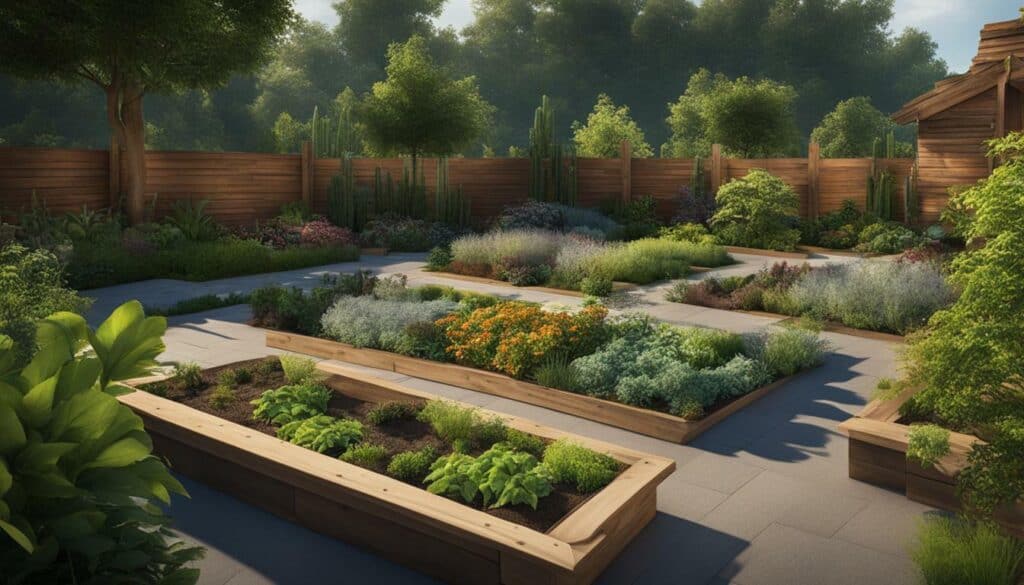
Soil quality is another crucial consideration. The soil should be well-drained and rich in organic matter. You can test your soil’s pH levels and nutrient content using a soil testing kit, which will help you determine if any amendments are needed. Certain flowers thrive in acidic soil, while others prefer alkaline or neutral conditions. By understanding your soil’s properties, you can select the right flowers that will flourish in your garden.
| Garden Location Checklist |
|---|
| ✔️ Six or more hours of direct sunlight |
| ✔️ Well-drained soil with organic matter |
| ✔️ Adequate airflow and protection from strong winds |
| ✔️ Accessible for regular watering and maintenance |
Avoid areas with excessive shade, as this can hinder plant growth and lead to leggy or weak stems. Additionally, consider the airflow in your chosen location. Strong winds can damage delicate blooms and foliage. If your garden is prone to gusty winds, consider planting windbreaks or creating natural barriers with taller shrubs or fencing to protect your flowers.
By carefully choosing the right location for your garden, you’ll give your flowers the best chance to thrive and bring beauty to your outdoor space.
Preparing the Soil for Your Garden
A healthy garden starts with healthy soil. In this section, I’ll guide you through the process of preparing your soil to create a nutrient-rich foundation for your plants.
When it comes to soil preparation, the first step is to test the soil’s pH level and nutrient content. This will help determine if any amendments or fertilizers are needed to ensure optimal plant growth. You can easily test your soil using DIY kits available at garden centers or by sending a sample to a local agricultural extension service.
Once you have the results, you can adjust the soil pH and nutrient levels accordingly. For example, if your soil is too acidic, you can add lime to raise the pH. If it lacks essential nutrients, organic matter like compost or well-rotted manure can be incorporated to enrich the soil.
| Soil Amendment | Benefit |
|---|---|
| Compost | Improves soil structure, moisture retention, and nutrient content. |
| Bone Meal | Provides a slow-release source of phosphorus for root development. |
| Wood Ash | Raises soil pH and provides potassium for overall plant health. |
Remember, preparation is key when it comes to creating a thriving garden. Taking the time to amend your soil will pay off with healthier plants and abundant blooms.
Now that your soil is ready, it’s time to start planning your garden layout and selecting the right plants. In the next section, we’ll delve into the exciting world of choosing the perfect plants for your garden. Stay tuned!
Summary:
In this section, we discussed the importance of preparing your soil to create a nutrient-rich foundation for your plants. We covered the process of testing the soil’s pH and nutrient content, and how to make amendments based on the results. We also highlighted some common soil amendments, such as compost, bone meal, and wood ash, and their benefits. By following these steps, you’ll be well on your way to establishing a healthy and thriving garden.
Choosing the Right Plants for Your Garden
With countless plant options available, narrowing down your choices can feel overwhelming. In this section, I’ll help you navigate the selection process and choose the perfect plants for your garden.
When selecting plants for your garden, it’s important to consider various factors such as your climate, soil type, and personal preferences. Some plants thrive in sunny locations, while others prefer shade. Take the time to assess your garden’s conditions and choose plants that are well-suited to your environment.

To make your decision easier, I’ve compiled a table below with some popular flower varieties and their characteristics. This table will give you a quick overview of each plant, including their bloom time, height, and water requirements. Use it as a reference when planning your garden.
| Plant | Bloom Time | Height | Water Requirements |
|---|---|---|---|
| Rose | Spring to fall | Varies | Moderate |
| Tulip | Spring | 6-24 inches | Regular |
| Sunflower | Summer | 3-10 feet | Low |
| Lavender | Summer | 1-3 feet | Low |
| Daffodil | Spring | 6-18 inches | Regular |
Remember, there are no right or wrong choices when it comes to selecting plants for your garden. It’s all about finding what works best for you and your space. Experiment with different plant combinations to create a visually pleasing and diverse garden that brings you joy throughout the seasons.
Timing Your Planting for Success
Timing is everything when it comes to planting your garden. In this section, I’ll teach you the art of timing your plantings for optimal growth and blooming. Whether you’re starting from seeds or transplanting seedlings, understanding the right time to plant is essential for a successful garden.
Starting with Seeds:
If you prefer to start your plants from seeds, it’s important to know the ideal planting time for each variety. Some seeds need to be sown indoors several weeks before the last frost date, while others can be directly sown into the garden once the soil has warmed up. Referencing a seed packet or a reliable gardening resource will provide you with accurate information on the recommended planting dates for different flowers.
Transplanting Seedlings:
When it comes to transplanting seedlings, timing is crucial to ensure their survival and healthy growth. You want to wait until all danger of frost has passed and the soil has warmed up, typically in the spring. This will give your seedlings the best chance to establish themselves and thrive in their new environment.
Recommended Planting Times for Popular Flowers
| Flower Variety | Recommended Planting Time |
|---|---|
| Roses | Early spring or fall |
| Petunias | After the last frost date |
| Zinnias | Directly sow after the last frost date |
| Marigolds | After the last frost date |
Remember, these are general guidelines, and the recommended planting times may vary depending on your specific climate and region. It’s always a good idea to consult local gardening resources or your nearest cooperative extension office for more precise information.
Now that you understand the importance of timing your plantings, you can confidently plan your garden and ensure the best possible outcome. Happy gardening!
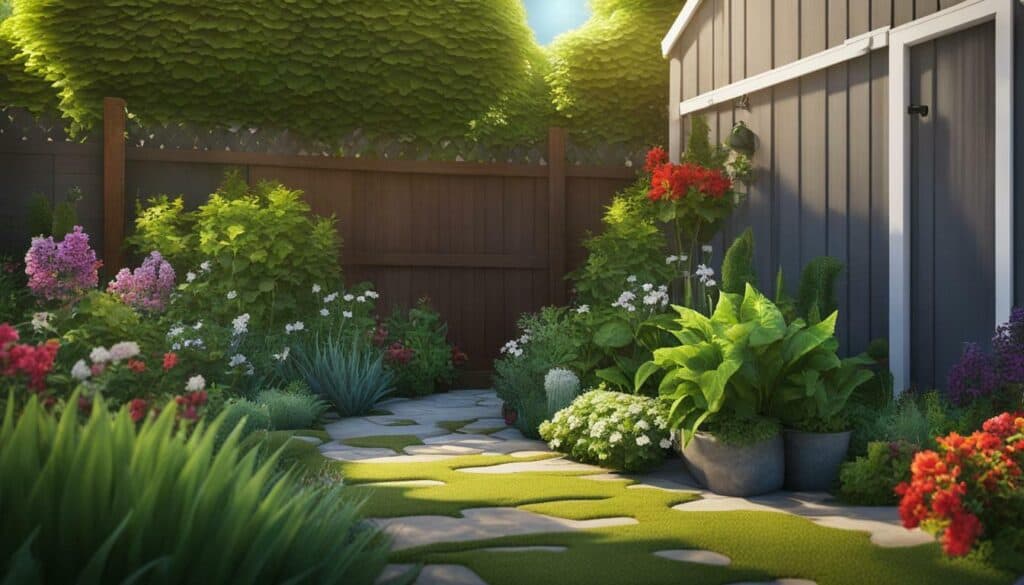
Sources:
- The Old Farmer’s Almanac – Planting Calendar
- Gardener’s Supply Company – How to Start Seeds
- University of Minnesota Extension
Watering Techniques for Healthy Blooms
Water is the lifeblood of your garden. In this section, I’ll share effective watering techniques to keep your plants healthy and blooming. Proper watering is essential for plant growth and vitality, but it can be tricky to get it just right. Too much water can lead to root rot, while too little can result in wilting and stunted growth. The key is finding the right balance.
One important technique is deep watering. This involves giving your plants a thorough soaking, allowing the water to penetrate deep into the soil. Shallow watering only wets the surface, leaving the roots thirsty and vulnerable. To deep water, use a soaker hose or drip irrigation system to deliver a slow, steady stream of water directly to the base of each plant. This method ensures that the roots receive adequate moisture and encourages them to grow deeper into the soil, making your plants more resilient.
Another technique to consider is watering in the morning. This allows the leaves and soil to dry out during the day, reducing the risk of fungal diseases. Watering in the evening or at night can create a damp, humid environment that promotes the growth of harmful pathogens. By watering in the morning, you give your plants the best chance to absorb the moisture they need and thrive throughout the day.
One handy tip to help you determine when to water is the finger test. Simply stick your finger about an inch into the soil at the base of your plants. If it feels dry, then it’s time to water. If it’s still moist, hold off for a day or two. Remember, it’s better to slightly underwater than overwater. Many plants can tolerate a little drought, but few can survive in waterlogged soil.
Now that you have a better understanding of watering techniques, it’s time to put your knowledge into practice. Remember to deep water, water in the morning, and use the finger test to gauge soil moisture. By mastering these techniques, you’ll be well on your way to maintaining healthy, vibrant blooms in your garden.
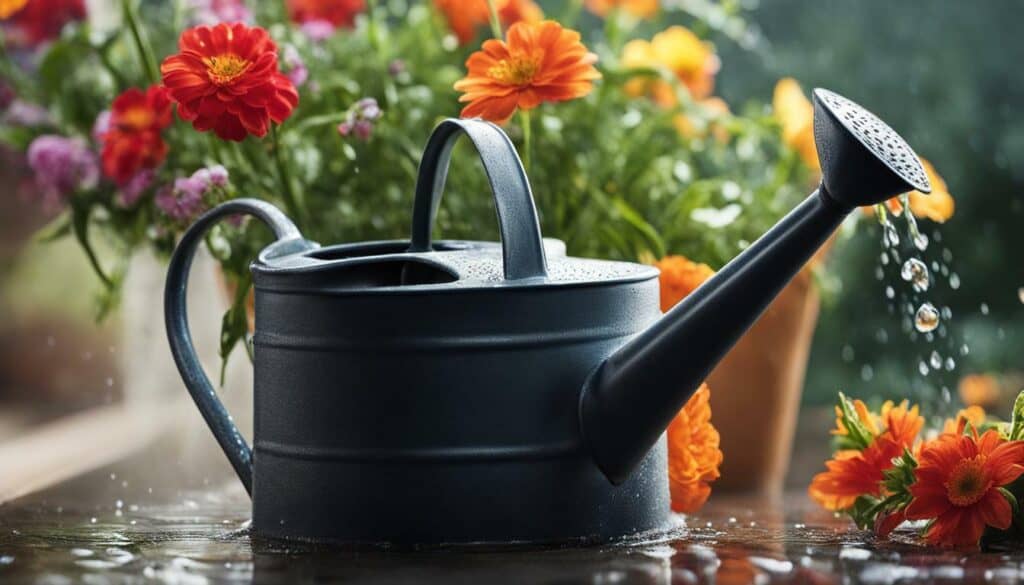
| Common Watering Mistakes | How to Correct |
|---|---|
| Overwatering | Allow the soil to dry out between waterings and adjust the frequency accordingly. |
| Underwatering | Check soil moisture regularly and water when needed. Increase watering during hot and dry periods. |
| Inconsistent watering | Create a watering schedule and stick to it. Use timers or reminders to ensure consistent watering. |
| Watering from above | Water at the base of the plants to avoid wetting the leaves, which can lead to fungal diseases. |
| Using sprinklers | Opt for more targeted watering methods like soaker hoses or drip irrigation for better water efficiency. |
Maintaining Your Gorgeous Garden
A well-maintained garden is a happy garden. In this section, I’ll guide you through the necessary maintenance tasks to keep your blooms flourishing all season long. Regular care and attention will help your plants stay healthy, ward off pests and diseases, and ensure a vibrant and beautiful garden.

One important aspect of garden maintenance is proper watering. Different plants have different moisture requirements, so it’s essential to understand the needs of each variety in your garden. Overwatering can lead to root rot and other issues, while underwatering can cause stress and stunted growth. Be sure to water your plants deeply, allowing the water to reach the root zone, and avoid watering the leaves to prevent fungal diseases.
Another key task is regular weeding. Weeds can compete with your plants for nutrients, sunlight, and water, hindering their growth. Take the time to remove weeds regularly to keep your garden beds neat and prevent them from spreading. You can use a garden hoe, hand tools, or even mulch to suppress weed growth. Remember, prevention is better than cure when it comes to weeds!
Table: Essential Garden Maintenance Tasks
| Task | Frequency |
|---|---|
| Weeding | Weekly |
| Pruning | As needed |
| Deadheading | Regularly |
| Fertilizing | Seasonally |
Pruning your plants when necessary helps maintain their shape, encourages healthy growth, and promotes blooming. Remove dead or damaged branches, as well as any crossing or overcrowded stems. Remember to use clean and sharp tools to prevent the spread of diseases.
Deadheading is another important task to keep your flowers blooming throughout the season. Regularly remove faded flowers to encourage new blooms and prevent the plant from diverting energy into producing seeds. This practice will help prolong the flowering period and keep your garden looking fresh and colorful.
Fertilizing your plants at the right time and with the appropriate nutrients is crucial for their overall health and vigor. Choose a fertilizer specifically formulated for the types of plants you have and follow the label instructions. Applying fertilizer in early spring and midsummer can provide your plants with the essential nutrients they need to thrive.
By following these maintenance tasks and staying on top of care throughout the season, you’ll create a flourishing garden full of vibrant blooms. Enjoy the rewards of your hard work and watch your garden thrive!
Dealing with Pests and Diseases
Even the most beautiful gardens face challenges from pests and diseases. In this section, I’ll share natural methods to tackle common garden pests and keep your flowers healthy.
When it comes to pest management, prevention is key. By maintaining a healthy garden ecosystem and implementing certain techniques, you can minimize the risk of pest infestations. One effective method is companion planting, which involves strategically placing plants that naturally repel pests near those that are susceptible. For example, marigolds are known to deter aphids, while garlic can keep pesky insects like beetles and caterpillars at bay.

To further protect your blooms, consider creating physical barriers such as netting or row covers. These can prevent insects and birds from damaging your plants without the need for harmful chemicals. Additionally, promoting biodiversity in your garden by including a variety of plants and flowers will attract beneficial insects that feed on pests, creating a natural balance.
| Pest | Natural control methods |
|---|---|
| Aphids | Attract ladybugs, lacewings, or parasitic wasps that prey on aphids |
| Slugs and snails | Create beer traps or use copper barriers to deter them |
| Fungal diseases | Avoid overwatering, provide proper air circulation, and remove infected plant parts |
| Spider mites | Regularly spray plants with water to wash away mites and their eggs |
Remember to regularly monitor your plants for signs of pests or diseases. Early detection and intervention can prevent further damage. If necessary, there are various organic insecticidal soaps and horticultural oils available that can target specific pests without harming beneficial insects.
By following these beginner gardening tips and utilizing natural pest control methods, you can ensure your flowers thrive and your garden remains stunning throughout the season. Let’s keep our gardens healthy and pest-free!
Dive into the World of Zinnias
Zinnias are a gardener’s delight, offering a burst of color and attracting pollinators. In this section, I’ll dive deeper into the world of zinnias and share my tips for successful cultivation.

When it comes to zinnias, there are numerous varieties to choose from, each with its own unique characteristics. From the small and dainty “Thumbelina” to the large and vibrant “Magellan,” there’s a zinnia for every garden style. Consider the height, flower shape, and color palette of each variety to find the perfect fit for your garden.
Choosing the Right Zinnias
To ensure a successful zinnia garden, it’s important to choose the right variety based on your location and climate. Some zinnias thrive in hot and dry conditions, while others prefer cooler temperatures. Check the seed packet or consult with a local nursery to determine which zinnias are best suited for your area.
| Popular Zinnia Varieties | Height | Flower Type | Color |
|---|---|---|---|
| Zinnia elegans “Thumbelina” | 6-8 inches | Double | Assorted |
| Zinnia elegans “Magellan” | 24-30 inches | Double | Various |
| Zinnia angustifolia “Crystal White” | 12-18 inches | Single | White |
Zinnias are relatively easy to grow, making them a great choice for beginners. They prefer full sun and well-drained soil, but can tolerate a variety of conditions. Start zinnias from seed indoors about 4-6 weeks before the last frost date or directly sow them in the garden once the soil has warmed up in spring. Keep the soil evenly moist until the seeds germinate, then water regularly to ensure healthy growth.
With their vibrant colors and ability to attract butterflies and bees, zinnias are a wonderful addition to any garden. Follow these tips, choose the right varieties, and watch your zinnias bloom into a stunning display of color and life!
DIY Garden Projects for Creative Enthusiasts
Gardening goes beyond planting and nurturing. In this section, I’ll inspire your creativity with exciting DIY garden projects that will make your green space truly unique. Whether you have a spacious backyard or a small balcony, these projects will add beauty and functionality to your outdoor oasis. Get ready to roll up your sleeves and embark on these fun and rewarding projects.
Create a Vertical Herb Garden
If you’re tight on space but crave fresh herbs at your fingertips, a vertical herb garden is the perfect solution. Repurpose a wooden pallet or build a simple frame using recycled materials. Attach small pots or hanging baskets to the frame and plant your favorite herbs. Hang it on a wall or fence, and voila! You’ll have a stunning vertical herb garden that not only saves space but also adds a touch of charm to your outdoor area.
Design an Upcycled Planter
Give new life to old household items by turning them into unique planters. Get creative with teapots, tin cans, vintage suitcases, or even old shoes. Just make sure to drill drainage holes and add a layer of pebbles for proper water drainage. Fill them with your favorite flowers or succulents, and watch them transform into eye-catching features. These upcycled planters are not only budget-friendly but also eco-friendly, adding a touch of character to your garden.
Build a Charming Garden Bench
Enhance your garden’s seating area with a DIY wooden bench. This project may require some basic carpentry skills, but the end result is worth it. Choose durable, weather-resistant wood, and follow a detailed plan or tutorial to guide you through the construction process. Once built, add cozy cushions and pillows for comfort and style. Your homemade garden bench will become a favorite spot to relax and enjoy the beauty of your blooming flowers.
| Project | Materials | Estimated Time |
|---|---|---|
| Vertical Herb Garden | Wooden pallet or frame, pots or hanging baskets, herbs | 1-2 hours |
| Upcycled Planter | Recycled household items, drill, pebbles, flowers or succulents | 30 minutes to 1 hour |
| Garden Bench | Durable wood, screws, cushions, pillows | 2-4 hours |
These DIY garden projects are just a glimpse of the endless possibilities to personalize your outdoor space. Let your imagination run wild and experiment with different materials, colors, and styles. Remember, the joy of gardening is not only in nurturing plants but also in creating a haven that reflects your unique personality and style.
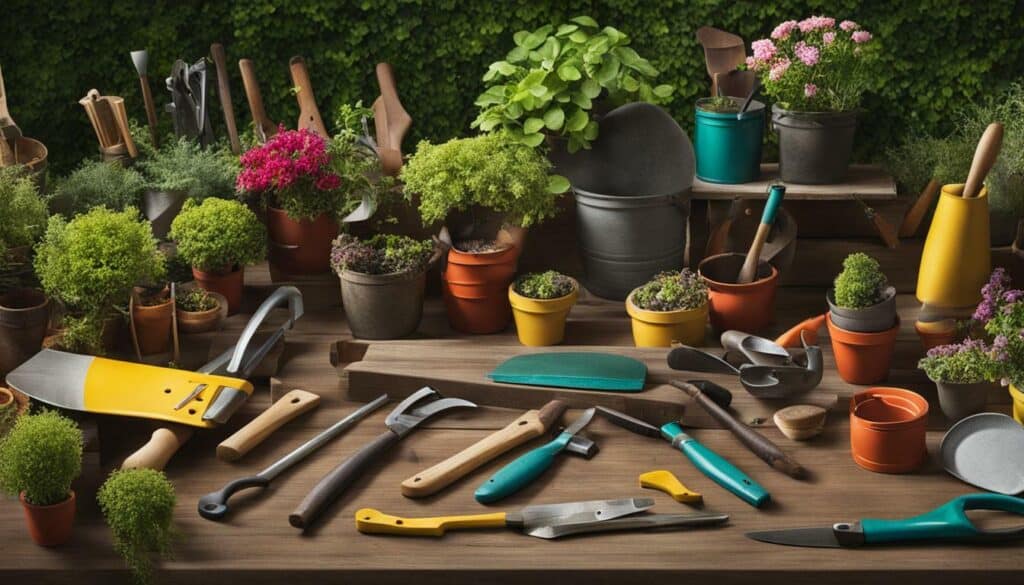
Conclusion
Congratulations on completing “Grow Blooms with Ease: Your Ultimate Tutorial Garden Guide!” I hope this comprehensive resource has empowered you to embark on your garden adventure and grow vibrant blooms with ease.
Throughout this guide, we have covered a wide range of topics to help you succeed in your flower gardening journey. We discussed the importance of choosing the right location for your garden, preparing the soil to provide optimal conditions for plant growth, and selecting the perfect plants based on your preferences and the specific needs of your garden.
We also explored the significance of proper planting timings, watering techniques, and essential maintenance tasks to ensure your garden thrives. Additionally, we delved into the world of zinnias, providing valuable insights into different varieties and cultivation techniques.
By following the tips and advice shared in this guide, you have the knowledge and tools to create a stunning garden filled with beautiful blooms. Remember, gardening is a journey of growth, so embrace the process and enjoy the rewards of your hard work.
Is Hiring a One Time Gardener Service Beneficial for Growing Blooms in My Garden?
Is hiring a one-time gardener service beneficial for growing blooms in your garden? Many people wonder, what is a one-time gardener service? This type of service involves hiring a professional gardener to come and take care of your garden one time. It can be beneficial as the expert can provide the necessary expertise and knowledge to ensure your blooms thrive.
FAQ
Q: What does the tutorial garden guide cover?
A: The tutorial garden guide covers various aspects of flower gardening, including choosing the right location, preparing the soil, selecting the right plants, planting timings, watering techniques, maintaining the garden, dealing with pests and diseases, and common questions about flower gardening.
Q: Does the guide provide specific information on growing zinnias?
A: Yes, the guide offers specific information on growing zinnias, including different varieties and their characteristics. It provides cultivation techniques and care instructions for successful zinnia growth.
Q: Who is the tutorial garden guide for?
A: The tutorial garden guide is designed for beginners who want to learn the basics of flower gardening. It offers valuable tips, insights, and step-by-step instructions to help novice gardeners create and maintain a beautiful garden with ease.
Q: How can I choose the right plants for my garden?
A: The tutorial garden guide provides guidance on selecting the right plants based on various factors such as climate, soil type, and personal preferences. It offers insights into choosing annuals, perennials, and specific flower varieties.
Q: What are some common pests and diseases in flower gardens?
A: Common pests and diseases in flower gardens include aphids, slugs, powdery mildew, and fungal infections. The tutorial garden guide provides organic solutions to combat these issues and emphasizes proactive pest management.
Q: What are some DIY garden projects I can try?
A: The tutorial garden guide explores fun and creative DIY garden projects, including container gardening, vertical gardening, and more. These projects can enhance the beauty and functionality of your outdoor space.
Q: How often should I water my plants?
A: The tutorial garden guide discusses various watering techniques to ensure your plants receive the right amount of moisture. It provides guidelines on watering frequency, methods, and common watering mistakes to avoid.

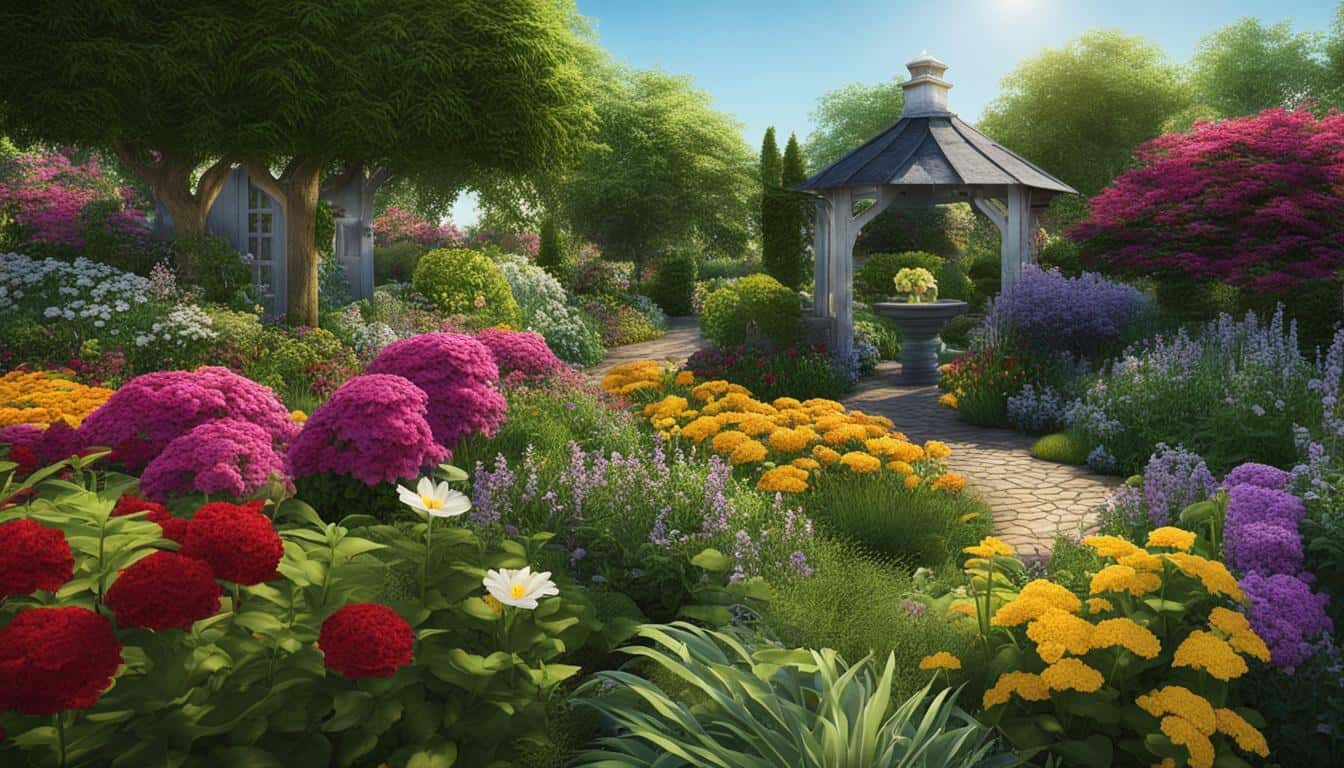



Leave a Reply